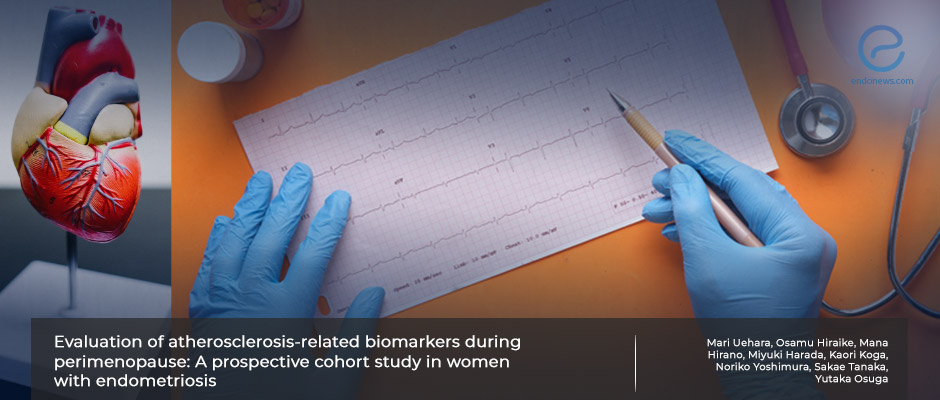Which parameter is useful in predicting cardiovascular disease risk in perimenopausal endometriosis patients?
Dec 30, 2022
Measuring pentosidine levels might be useful in predicting the atherosclerosis risk in perimenopausal patients with endometriosis.
Key Points
Highlight
- Pentosidine is an advanced glycation end product known to play an important role in atherosclerosis development.
- Its levels are significantly increased in perimenopausal women with higher cardio-ankle vascular index (CAVI) change rates.
Importance
- Endometriosis contributes to the increased risk of cardiovascular diseases, mainly atherosclerosis in perimenopausal women.
- Hormonal imbalances cause perimenopausal women to be at more risk for developing atherosclerosis.
What’s done here
- This is a prospective cohort study of perimenopausal women with endometriosis.
- It aimed to evaluate two indicators of arterial stiffness; CAVI and ankle-brachial index (ABI) and their functionality in postmenopausal women with endometriosis.
- The inflammatory indicators, the lumbar spinal bone mineral density, CAVI and ABI values, the medical history, and the demographic factors were evaluated and statistically analyzed.
- The annual CAVI change rate was analyzed and patients were classified into mild, moderate, and severe change according to the rate.
Key results
- One-third of the total 207 patients were postmenopausal, the mean menopause age was 46.8 years.
- None of the studied parameters were found to be significantly associated with high CAVI.
- ABI showed a significant correlation with elevated total cholesterol, low-density lipoprotein cholesterol, and estradiol levels.
- Higher pentosidine levels were observed in the severe CAVI change group.
- Higher pentosidine levels were a significant risk factor for a larger annual CAVI change rate.
Strengths
- The strength of the study was the longitudinal evaluation of vascular function in perimenopausal patients with endometriosis.
- The limitations included the comparatively small population of patients, brief follow-up period, and heterogeneous population of patients with endometriosis.
Lay Summary
Cardiovascular disease is known to be the leading cause of death among women worldwide. Studies have shown that postmenopausal women are at a greater risk as well as women who undergo premature menopause proving the effect of hormonal imbalances on the development of cardiovascular events. The main contributor to cardiovascular disease is atherosclerosis.
The assessment of vascular function is performed with arterial stiffness tests: cardio-ankle vascular index (CAVI) which shows arterial elasticity and ankle-brachial index (ABI) which is the ratio of the systolic blood pressure in the ankle to the upper arm. The changes in these indices indicate a risk of atherosclerosis-related diseases. Taking into account that atherosclerosis and endometriosis show similarities with both being systemic chronic inflammatory diseases, Uehara et al. from Japan conducted a prospective cohort study and aimed to evaluate these indices and their functionality in postmenopausal women with endometriosis. The study was published in the December 2022 issue of The Journal of Obstetrics and Gynaecology Research.
The inflammatory indicators, the lumbar spinal bone mineral density, CAVI and ABI values, the medical history, and the demographic factors of the 207 patients aged ≥40 years enrolled in the study were evaluated. The annual CAVI change rate was analyzed and patients were classified into mild, moderate, and severe change according to the rate. One-third of the patients were postmenopausal with a mean menopause age of 46.8 years.
An increased CAVI means an increased risk of cardiovascular events and conversely, ABI decreases as arterial occlusion occurs. Among the parameters that influenced CAVI, apart from age at menopause, none of the other factors were found to be associated with high CAVI. With these findings, the authors suggested that endometriosis patients do not show elevated CAVI values.
ABI on the other hand showed a significant correlation with elevated total cholesterol, low-density lipoprotein cholesterol, and estradiol levels. The changes in these parameters indicated impairment in vascular function according to the authors.
On the assessment of the annual CAVI change rate, total cholesterol and pentosidine levels were weakly positively correlated and the presence of previous hormone therapy was weakly negatively correlated with CAVI change. Higher pentosidine levels were observed in the severe CAVI change group and they were also shown to be a significant risk factor for a larger annual CAVI change rate. It is therefore concluded that measuring pentosidine levels might be useful in predicting the risk of cardiovascular disease in perimenopausal patients with endometriosis.
Research Source: https://pubmed.ncbi.nlm.nih.gov/36168257/
endometriosis cardiovascular disease atherosclerosis pentosidine

